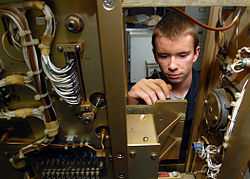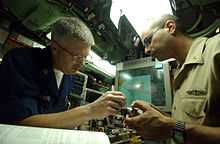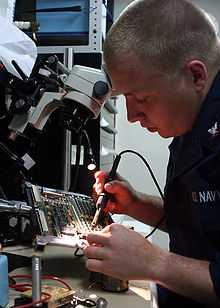Electronics technician (United States Navy)
| Electronics technician | |
|---|---|
 Rating insignia | |
| Issued by: United States Navy | |
| Type | Enlisted rating |
| Abbreviation | ET |
| Specialty | Technical |

The United States Navy occupational rating of electronics technician (abbreviated as ET) is a designation given by the Bureau of Naval Personnel (BUPERS) to enlisted members who satisfactorily complete initial Electronics Technician "A" school training.
History of the rating
The electronics technician rating was originally established as radio technician in 1942 during the height of World War II. The rating badge adopted was that of the established radioman rating, and remained until 1945, when the rating name was changed to electronic technician's mate. In 1948, the Navy changed the name of the rating to electronics technician, and a new rating badge was created, both of which are still in use today.[1]
"A" School and "C" School Training
Surface ETs must complete Apprentice Technical Training (ATT), followed by Electronics Technician "A" School. Non-Nuclear ET's attend ATT and "A" School at Naval Training Center Great Lakes, Illinois. Submarine ETs (navigation and communications) must complete Basic Enlisted Submarine School, ATT, Tactical Computer and Network Operator, and "A" School at Naval Submarine School in Groton, CT. Nuclear ET's attend "A" School at Naval Weapons Station Charleston in Goose Creek, South Carolina for Nuclear Field "A" School. While the Surface ET's "A" school was originally very hands-on, it is now entirely conducted through self-study computer based training with 7 hands-on labs used to demonstrate the student's aptitude with the equipment they will be working with once out in fleet. Nuclear ET's "A" school is extremely hands on with a curriculum that includes basic math, basic electrical theory, electrical fundamentals, digital microprocessor design, and instrumentation and control equipment. Nuclear ET's endure eight hours of lecture and labs five days a week for six months with extra study hours ranging from voluntary to forty additional hours per week. Once "A" school is complete, most ETs move onto a "C" school to learn more in-depth knowledge of electronics for one specific system used aboard ship. This earns them a DNEC, which is further used to determine where they will be stationed after schooling is finished. ETs may be in training for 2 years or more and the rating often requires the sailor to extend their enlistment to 6 years.
Non-Nuclear ETs are responsible for the electronic equipment used to send and receive messages, detect enemy planes and ships, and determine target distance. They maintain, repair, calibrate, tune, and adjust all electronic equipment used for communications, detection and tracking, recognition and identification, navigation, and electronic countermeasures.
Nuclear ETs are responsible for the electronic equipment used to monitor and control the nuclear reactors onboard US Navy vessels. They maintain, repair, calibrate, tune, adjust, and operate all nuclear electronic equipment responsible for safe operation of the nuclear reactor(s).
ET subcategory specialty areas

Surface
Surface ETs maintain and repair electronics equipment such as radar, communication and navigation equipment. ETs can also perform the function of an IT by operating and maintaining computer networks depending upon what billet (job) they serve in. The ET and FC (Advanced Electronics Computer Fields) ratings comprise the basis of the ship's combat systems department aboard ships and are responsible for maintaining the ship's readiness for combat operations.
Entry rates PO3-PO2 (E4-E5) specialize as electronics communications technician, electronics data systems technician, or electronics radar systems technician. PO1-CPO (E6-E7) are electronics systems managers.[2]
Submarines: radio and navigation
Submarine ETs are divided into two distinct job functions, radio ET(R) and navigation ET(V). Radio ETs are responsible for maintaining, operating, and administrating the submarine's radio communication and ESM equipment, systems and programs, including the submarine's masts and antennas. Navigation ETs are responsible for maintaining, operating, and administrating the submarine's navigation, military/commercial radar, interior communications, non-nuclear remote indication and control circuitry equipment systems and programs in addition to being responsible for all honors and naval ceremonies conducted on the ship.
Nuclear
Nuclear-trained ETs perform duties in nuclear propulsion plants primarily in operating, maintaining, and repairing reactor instrumentation and control systems. Nuclear ETs may be assigned as an operator to a nuclear-powered aircraft carrier, as an instructor at a Navy nuclear power training command, or as a technician at a shipyard or other nuclear support facility. Additionally nuclear ETs may volunteer for nuclear submarine service. Nuclear ETs are the only rating in the Navy that can qualify as a reactor operator of a naval nuclear propulsion plant.
Training
Nuclear ETs complete several different phases of training in order to be able to operate a naval nuclear propulsion plant. In order to be selected for nuclear training prospective Navy recruits must have a high enough cutscore on the Armed Service Vocational Battery (ASVAB) that score being greater than 88 and the Navy Advanced Placement Test (NAPT) that score being greater than 55%. Prospective nuclear recruits are then sent to Navy boot camp where prospective nuclear trainees are selected in a 50-30-20 ratio to be trained as nuclear machinist's mates, nuclear electrician's mate, or nuclear electronics technicians. Those who are selected to be nuclear electronics technicians then enter the Navy Nuclear Pipeline to train to become a nuclear ET.
In the first stage of training in the Navy Nuclear Pipeline, prospective nuclear ETs are trained for six months at the Nuclear Field 'A' School (NFAS) at the Naval Nuclear Power Training Command (NNPTC) in Goose Creek, SC. The curriculum at NFAS includes a mathematics refresher course, basic electronics theory, analog electronics theory (EFUNDS), digital electronics theory, and instrumentation and control equipment (I&CE) theory and maintenance. The curriculum is presented in a high paced manner that ramps up over the term at NFAS in order to prepare students for the difficulties of Nuclear Power School. The curriculum is very similar to that which is presented to nuclear electricians except that nuclear electricians train in electrical motor and generator theory and maintenance instead of I&CE theory and maintenance. Due to the specialized training given at NFAS, nuclear ETs who have trained there instead of another ET 'A' school are not qualified to be assigned to billets designed for non-nuclear ETs. Nuclear ETs are more highly trained in the fundamentals of electrical theory and thus the money spent on their training would be wasted were they to not pursue a nuclear career. Personnel who are disqualified from Navy nuclear work ('de-nuked') or who fail to qualify for Navy nuclear work later in the pipeline are reclassified into another rating in order to remain in the Navy.

In the second stage of training in the Navy Nuclear Pipeline, ETs are trained for six months at the Nuclear Power School at the NNPTC. The curriculum for ETs at the Nuclear Power School includes a higher level mathematics (Calculus) refresher course, introduction to nuclear propulsion systems, Navy nuclear mechanical, electrical, and electronics system design, reactor theory, health physics, basic materials science, and chemistry as it applies to nuclear power plants. The curriculum is similar for MMs, EMs, and ETs, except that each rating focuses more on their particular nuclear system design (for nuclear ETs this means that they have additional training in nuclear electronics design).
In the third and final stage of training in the Navy Nuclear Pipeline, ETs are trained for six months at one of four Navy nuclear prototype training units (NPTUs). Two NPTUs are moored training ships (MTS) using S5W reactors located at the Naval Weapons Station in Charleston, SC., and two additional NPTUs are land-based prototype units using a S7G reactor and a S8G reactor located in Saratoga Springs, NY. The curriculum for ETs at an NPTU includes detailed health physics training, design, operation, and maintenance of electronics systems for the NPTU, nuclear watchstanding procedures, and nuclear casualty procedures. Unlike the first two stages of the Navy Nuclear Pipeline where the curriculum is presented in a typical classroom format, training at an NPTU is self-motivated training where students are required to research different aspects of a nuclear propulsion plant design, operation, or theory and demonstrate this knowledge in an oral interview with a qualified nuclear instructor. Additionally, nuclear ETs must perform graded watches under the instruction of a qualified nuclear instructor where they operate a particular piece of nuclear equipment or respond to a casualty. The culmination of training for a nuclear ET is an oral board where a nuclear ET must demonstrate the knowledge of all procedures, equipment, theory expected for a nuclear reactor operator. Completion of NPTU qualifies a nuclear ET to stand watch on the NPTU or to train to operate nuclear propulsion plants on a nuclear aircraft carrier or submarine. Additionally, it gives the individual the nuclear ET Navy Enlisted Classification (NEC), and the individual is then said to be "nuclear qualified."
Upon completion of the Naval Nuclear Pipeline, most nuclear qualified ETs are sent to nuclear aircraft carriers or nuclear submarines. On a nuclear-powered aircraft carrier, nuclear ETs are sent to a nuclear training division where they train to qualify to operate the nuclear reactors of the ship in a similar way to NPTU for about six months prior to being sent to a reactor control division. In contrast, on a submarine nuclear ETs are directly assigned to the Reactor Controls division and are directed to qualify different watches incrementally. Due to the smaller number of personnel on a nuclear submarine, nuclear ETs must also cross qualify on several nuclear electrician watches. Since nuclear ETs are required to stand watches, perform maintenance, and train and qualify on additional submarine systems, it is not uncommon for it to take over 12 months for a nuclear ET to become fully qualified as a reactor operator, shutdown reactor operator, and all intermediate watches. Upon subsequent transfer to an NPTU or another nuclear ship, operators are required to re-qualify the same watches in only about 6 months.
Even upon completion of being fully qualified on all nuclear ET watches ("qualified in rate"), additional proficiency and casualty training is required for all nuclear ETs. On a ship this generally includes general Engineering or Reactor Department training, Reactor Controls division training, periodic exams and interviews, monitored maintenance and operations, periodic watch re-qualifications, and monitored tactical or casualty drills.
Usually after a nuclear ET is "fully qualified" the individual is sent to an "in-rate" technical school ETMS where the technician studies electronic troubleshooting and repair on shipboard equipment. Completion of this school allows the technician to be designated with the NEC 3373.
Senior nuclear ETs (typically those who hold the rank of petty officer first class or higher) are expected to qualify for senior supervisory watches. Self-motivated training for this includes the detailed operations of all nuclear systems on a ship (not just the nuclear ET specific parts) focusing on the big picture view of nuclear operations and casualty response. The training time required to qualify for senior supervisory watches depends on the individual.
See also
References
- ↑ "Compilation of Enlisted Ratings and Apprenticeships, U.S. Navy, 1775 to 1969". History.navy.mil. Retrieved 2012-05-16.
- ↑ Navy Enlisted Occupational Standard for Electronics Technician (ET). Retrieved 2012-07-16.